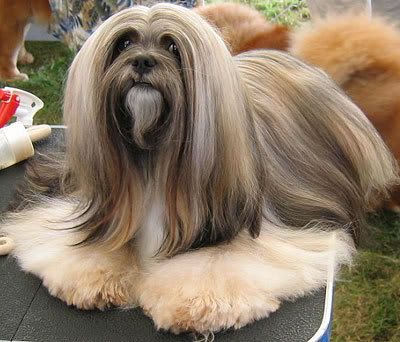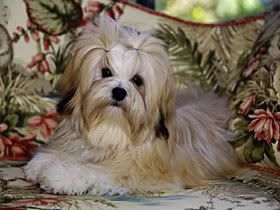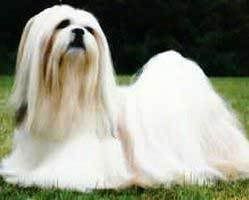Post by charmingnancy on Feb 16, 2009 12:49:22 GMT -5
Lhasa Apso
Group: 6- Non Sporting
Origin: Tibet
Purpose: To guard Tibetan palaces and temples

Description:
The Lhasa Apso was bred in Tibetan monasteries for over 2,000 years and was originally named the Abso Send Kye, "Bark Lion Sentinel Dog". The Lhasa Apso has a small, sturdy frame covered in a long, dense coat that can come in light brown, cream, slate, brown, black and white. Overall, the Lhasa Apso looks cheerful but determined.
Appearance- Breed Standards:
Coat and Colour:
The adult coat is heavy, straight, hard, not woolly or silky, of good length and dense. The coat should be parted from the nose to the root of the tail. The head should have heavy furnishings with a good fall over the eyes. Good whiskers and beard. In Obedience the hair may be tied back from the eyes. Ears, legs, tail, forequarters, hindquarters and neck should be heavily furnished. Feet should be surrounded with hair. The pads have hair between them which may be trimmed. All colours and mixtures of colours considered equal.
Head: Skull narrow, falling away from behind the eyebrow ridges to a marked degree. Cranium almost flat, not domed or apple-shaped. Viewed from the front, the top of the cranium is narrower than the width at the level of the eyes. The foreface is straight. Muzzle: The length from the tip of the nose to the inside corner of the eye to be roughly 1-1/2 inches or the length from the tip of the nose to the inside corner of the eye to be roughly one-third of the total length from the tip of the nose to the back of the skull. A square muzzle is objectionable. Nose black. The tip of the nose is level with or very slightly below the lower eye rim when viewed from the front. Mouth: Bite - reverse scissors (upper incisors just touching the inner face of the lower incisors). Full dentition. Incisors (6) to be in a straight line. Acceptable bite - level (the front incisors of the upper and lower jaw meeting edge to edge). Undesirable bite - overshot. Excessively undershot (more than 1/8 inches / .32 cm). The teeth must not show when the mouth is closed. Lips black. Eyes dark brown. Not large and full or small or sunken. The iris should be of reasonable size, no white showing at the base or top of the eye. The eyes are frontally placed in an oval-shaped black rim. Ears pendant. The ears should be well set back on the skull at eye level (not level with the topline of the
skull). The leather should hang close to the head and in an adult dog should reach the level of the lower jaw.
Neck: Well set on to the shoulders. Long enough to carry the head well creating an impression of elegance. Slightly arched.
Forequarters: Shoulders strong, muscular, well laid back. The upper arm should not be “Terrier straight,” allowing for the desired width and depth of the chest. Lower Arm: the forelegs should not be bowed. From the front when the dog is standing, the legs should be straight parallel, elbows well under the body. The forelimbs support a good share of the body weight when the dog is standing or when moving at a slow pace. The pasterns should be straight and firm when viewed from the front. Slight deviation from the perpendicular when viewed from the side. Feet: short, round and compact with good pads turning neither in nor out. Ideally, nails are black. In particolored or light-coloured coats, light nails and pads are permitted. Dewclaws permissible.
Body:
Topline level. Chest well ribbed up, i.e., the ribs should extend well back along the body. The slightly curved ribs should not extend below the elbows. Loin: too long a loin adds excess length to the back and results in a loss of strength to the forepart of the body. If the loin is too short there will be a loss of flexibility. The loin should be firmly muscled. Croup: the angle formed by the pelvis and the backbone should not be more than 30 degrees from the horizontal. This angulation gives power for the forward propulsion. Abdomen: tucked up to a shallower depth at the loin.
Hindquarters:
Strongly muscled and in balance with the forequarters. Hocks, when viewed from the rear at a stance, should be strong, straight, and parallel, turning neither in nor out. When viewed from the side, they should be perpendicular to the ground and not stretched out beyond the rump of the dog. Stifle bend: the stifle is moderately bent. Feet: same as in forequarters.
Tail: Set high. Carried forward close to the back with the tip draped on either side of the body. The tail should not rise vertically. A kink in the end is permissible. A low carriage of the tail is a serious fault.
Gait: An easy moving free-flowing trot is the normal pace of the Lhasa Apso. This trot shows the character of his movement at its best and is what should be aimed for. The pads should be seen as the dog moves away indicating a strong hind drive which is balanced by a good reach of the forelegs. Moving too quickly in the ring throws the dog off gait and should be avoided.
Disqualifications:
Lhasa Apsos over 11-1/2 inches (29.2 cm) are to be disqualified.
Size:
Ideal size for dogs is between 10-11 inches (25.4-27.9 cm) with up to 11- 1/2 inches (29.2 cm) permissible. Bitches should be slightly smaller.

Temperament:
Lhasa Apso is not your typical lapdog. Lively, friendly and outgoing around the home, it is also bold and full of spunky attitude. These charming and elegant canines believe themselves to be the protector of the household, and they take that job very seriously. The Lhasa Apso develops close bonds with its owner and may seem suspicious of strangers, but it has an excellent sense of restraint and judgement.
The Lhasa Apso is very strong-willed. When training, it’s important to try and maintain the authority. They do not respond to harsh training, but they do respect a firm, positive leader. You’ll have to earn the respect of a Lhasa Apso, but once you do you have a friend for life.
Health:
The Lhasa Apso is a very healthy and hardy breed, relatively free of health problems. Kidney disease is the most serious health problem found in the Lhasa. Common health issues include hip dysplasia, respiratory ailments and skin disorders. Possible health concerns include Entropion (inverted eyelids), Distichiasis (abnormal eyelash growth), Progressive retinal atrophy (PRA) (gradual deterioration of the retina), and Renal cortical hypoplasia (failure of both kidneys to function properly).
Average Lifespan:
The average life expectancy is 12 to 18 years.

History:
It is thought that the Lhasa terrier (the British called the Lhasa Apso by this name when it first arrived in England) had developed in the area of Lhasa, the capital of Tibet, about 800 years ago. However, this breed of dog could also be found in Bhutan and other countries bordering on Tibet.
This bold and alert canine’s duty was to guard the interior of the Tibetan palaces, while its massive and imposing partner (the Tibetan Mastiff) was charged with guarding the outside.
Mrs. A. McLaren Morrison brought the Lhasa Apso to England in 1901. This was this breed's first appearance in the world outside of the region of Tibet. The breed gained in popularity rapidly and the following year, 1902, the Kennel Club of England recognized the Lhasa terrier as a separate and unique breed of dog. World War I had a huge impact on this breed, even as other breeds of dog had suffered. After peace had been declared, breeders of the Lhasa imported several dogs from China. These dogs were not Lhasas, but Shih Tzus. Nevertheless, they were included in the breeding programs, that was how serious the impact of war had been on this breed.
C. Suydam Cutting and his wife, Mary, were Americans from Gladstone, New Jersey. In the 1930's Mr. Cutting arranged to meet with the 13th Dalai Lama through a series of letters. Mr Cutting was not only a world traveler, but also a naturalist. The two men became friends, and as is custom exchanged gifts, and among these gifts were Lhasa Apsos. So the Lhasa Apso now traveled to the new world to continue its tradition of guardian and companion to humans.
The A.K.C. recognized the Lhasa in 1935, but it was as a Lhasa terrier, just like in England. This was not changed until 1944. The Lhasa Apso stayed in the Terrier Group until 1959, when it was transferred to the Nonsporting Group. Change comes slowly, but comes nonetheless.
The American Lhasa Apso Club was formed in 1959 and recognized by the AKC as the parent club for the breed.
Sources:
CKC
Canada's Guide to Dogs
Dogster
Bark Bytes
Pictures:
Photobucket
Group: 6- Non Sporting
Origin: Tibet
Purpose: To guard Tibetan palaces and temples

Description:
The Lhasa Apso was bred in Tibetan monasteries for over 2,000 years and was originally named the Abso Send Kye, "Bark Lion Sentinel Dog". The Lhasa Apso has a small, sturdy frame covered in a long, dense coat that can come in light brown, cream, slate, brown, black and white. Overall, the Lhasa Apso looks cheerful but determined.
Appearance- Breed Standards:
Coat and Colour:
The adult coat is heavy, straight, hard, not woolly or silky, of good length and dense. The coat should be parted from the nose to the root of the tail. The head should have heavy furnishings with a good fall over the eyes. Good whiskers and beard. In Obedience the hair may be tied back from the eyes. Ears, legs, tail, forequarters, hindquarters and neck should be heavily furnished. Feet should be surrounded with hair. The pads have hair between them which may be trimmed. All colours and mixtures of colours considered equal.
Head: Skull narrow, falling away from behind the eyebrow ridges to a marked degree. Cranium almost flat, not domed or apple-shaped. Viewed from the front, the top of the cranium is narrower than the width at the level of the eyes. The foreface is straight. Muzzle: The length from the tip of the nose to the inside corner of the eye to be roughly 1-1/2 inches or the length from the tip of the nose to the inside corner of the eye to be roughly one-third of the total length from the tip of the nose to the back of the skull. A square muzzle is objectionable. Nose black. The tip of the nose is level with or very slightly below the lower eye rim when viewed from the front. Mouth: Bite - reverse scissors (upper incisors just touching the inner face of the lower incisors). Full dentition. Incisors (6) to be in a straight line. Acceptable bite - level (the front incisors of the upper and lower jaw meeting edge to edge). Undesirable bite - overshot. Excessively undershot (more than 1/8 inches / .32 cm). The teeth must not show when the mouth is closed. Lips black. Eyes dark brown. Not large and full or small or sunken. The iris should be of reasonable size, no white showing at the base or top of the eye. The eyes are frontally placed in an oval-shaped black rim. Ears pendant. The ears should be well set back on the skull at eye level (not level with the topline of the
skull). The leather should hang close to the head and in an adult dog should reach the level of the lower jaw.
Neck: Well set on to the shoulders. Long enough to carry the head well creating an impression of elegance. Slightly arched.
Forequarters: Shoulders strong, muscular, well laid back. The upper arm should not be “Terrier straight,” allowing for the desired width and depth of the chest. Lower Arm: the forelegs should not be bowed. From the front when the dog is standing, the legs should be straight parallel, elbows well under the body. The forelimbs support a good share of the body weight when the dog is standing or when moving at a slow pace. The pasterns should be straight and firm when viewed from the front. Slight deviation from the perpendicular when viewed from the side. Feet: short, round and compact with good pads turning neither in nor out. Ideally, nails are black. In particolored or light-coloured coats, light nails and pads are permitted. Dewclaws permissible.
Body:
Topline level. Chest well ribbed up, i.e., the ribs should extend well back along the body. The slightly curved ribs should not extend below the elbows. Loin: too long a loin adds excess length to the back and results in a loss of strength to the forepart of the body. If the loin is too short there will be a loss of flexibility. The loin should be firmly muscled. Croup: the angle formed by the pelvis and the backbone should not be more than 30 degrees from the horizontal. This angulation gives power for the forward propulsion. Abdomen: tucked up to a shallower depth at the loin.
Hindquarters:
Strongly muscled and in balance with the forequarters. Hocks, when viewed from the rear at a stance, should be strong, straight, and parallel, turning neither in nor out. When viewed from the side, they should be perpendicular to the ground and not stretched out beyond the rump of the dog. Stifle bend: the stifle is moderately bent. Feet: same as in forequarters.
Tail: Set high. Carried forward close to the back with the tip draped on either side of the body. The tail should not rise vertically. A kink in the end is permissible. A low carriage of the tail is a serious fault.
Gait: An easy moving free-flowing trot is the normal pace of the Lhasa Apso. This trot shows the character of his movement at its best and is what should be aimed for. The pads should be seen as the dog moves away indicating a strong hind drive which is balanced by a good reach of the forelegs. Moving too quickly in the ring throws the dog off gait and should be avoided.
Disqualifications:
Lhasa Apsos over 11-1/2 inches (29.2 cm) are to be disqualified.
Size:
Ideal size for dogs is between 10-11 inches (25.4-27.9 cm) with up to 11- 1/2 inches (29.2 cm) permissible. Bitches should be slightly smaller.

Temperament:
Lhasa Apso is not your typical lapdog. Lively, friendly and outgoing around the home, it is also bold and full of spunky attitude. These charming and elegant canines believe themselves to be the protector of the household, and they take that job very seriously. The Lhasa Apso develops close bonds with its owner and may seem suspicious of strangers, but it has an excellent sense of restraint and judgement.
The Lhasa Apso is very strong-willed. When training, it’s important to try and maintain the authority. They do not respond to harsh training, but they do respect a firm, positive leader. You’ll have to earn the respect of a Lhasa Apso, but once you do you have a friend for life.
Health:
The Lhasa Apso is a very healthy and hardy breed, relatively free of health problems. Kidney disease is the most serious health problem found in the Lhasa. Common health issues include hip dysplasia, respiratory ailments and skin disorders. Possible health concerns include Entropion (inverted eyelids), Distichiasis (abnormal eyelash growth), Progressive retinal atrophy (PRA) (gradual deterioration of the retina), and Renal cortical hypoplasia (failure of both kidneys to function properly).
Average Lifespan:
The average life expectancy is 12 to 18 years.

History:
It is thought that the Lhasa terrier (the British called the Lhasa Apso by this name when it first arrived in England) had developed in the area of Lhasa, the capital of Tibet, about 800 years ago. However, this breed of dog could also be found in Bhutan and other countries bordering on Tibet.
This bold and alert canine’s duty was to guard the interior of the Tibetan palaces, while its massive and imposing partner (the Tibetan Mastiff) was charged with guarding the outside.
Mrs. A. McLaren Morrison brought the Lhasa Apso to England in 1901. This was this breed's first appearance in the world outside of the region of Tibet. The breed gained in popularity rapidly and the following year, 1902, the Kennel Club of England recognized the Lhasa terrier as a separate and unique breed of dog. World War I had a huge impact on this breed, even as other breeds of dog had suffered. After peace had been declared, breeders of the Lhasa imported several dogs from China. These dogs were not Lhasas, but Shih Tzus. Nevertheless, they were included in the breeding programs, that was how serious the impact of war had been on this breed.
C. Suydam Cutting and his wife, Mary, were Americans from Gladstone, New Jersey. In the 1930's Mr. Cutting arranged to meet with the 13th Dalai Lama through a series of letters. Mr Cutting was not only a world traveler, but also a naturalist. The two men became friends, and as is custom exchanged gifts, and among these gifts were Lhasa Apsos. So the Lhasa Apso now traveled to the new world to continue its tradition of guardian and companion to humans.
The A.K.C. recognized the Lhasa in 1935, but it was as a Lhasa terrier, just like in England. This was not changed until 1944. The Lhasa Apso stayed in the Terrier Group until 1959, when it was transferred to the Nonsporting Group. Change comes slowly, but comes nonetheless.
The American Lhasa Apso Club was formed in 1959 and recognized by the AKC as the parent club for the breed.
Sources:
CKC
Canada's Guide to Dogs
Dogster
Bark Bytes
Pictures:
Photobucket

